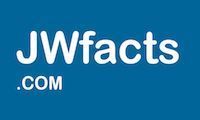home > interesting topics > random musings > freemason
Was Charles Taze Russell a Freemason?
When researching Jehovah's Witnesses online, you will come across statements that Charles Taze Russell was a Freemason, 33rd degree Mason, part of the Illuminati, Satanist, or even a reptilian.
Many of these statements link back to the book The Watchtower and the Masons: A Preliminary Investigation, Fritz Springmeier (1990).

Do the facts show that Russell was really a Freemason?
This article has the following parts:
- How to Verify a Freemason
- What Jehovah's Witnesses Historians Say
- What Freemasons Say
- Famous Freemasons
- "Proofs" Examined
How to Verify a Freemason
Wikipedia article "List of Freemasons (A-D)", explains how to verify someone as being a Freemason:
"Standards of "proof" for those on this list may vary widely; some figures with no verified lodge affiliation are claimed as Masons if reliable sources give anecdotal evidence suggesting they were familiar with the "secret" signs and passes, but other figures are rejected over technical questions of regularity in the lodge that initiated them. Where available, specific lodge membership information is provided; where serious questions of verification have been noted by other sources, this is also indicated."
The surest way to know if someone was a Mason is by searching in the association lists of the Lodges. Alternatively, one can know if someone was a Mason by means of their knowledge of the signals and secret passes. Jehovah's Witness historians show Russell does not satisfy either test.
What Jehovah's Witnesses Historians Say
Noted researchers of Jehovah's Witness history, including Professor James Penton, conclude Russell was not a Freemason.
James Penton
In his book Apocalypse Delayed: The Story of Jehovah's Witnesses, Third Edition, on pages 64 and 415, Penton explains Russell was neither a Mason or Occultist.
"Yet over the years critics of Russell and Jehovah's Witnesses have continued to use Ross's fallacious statement plus a number of other charges, two of which should be regarded as utter nonsense. The first is that Russell was into occult practices, and the second is that he was a Freemason.127 The first claim is based almost entirely on his use of certain symbols such as the winged disk that appeared on copies of Studies in the Scriptures and the cross and crown motif that appeared in Watch Tower literature and was often worn by Bible Students as religious ornaments. But instead of being drawn from Egyptian paganism as has been asserted by Russell's adversaries, the winged disks simply represented "the sun of righteousness" that would "arise with healing in his wings" according to Malachi 4: 2. As for the cross and crown motif, it was simply a common one in the nineteenth and earlier centuries that was used by many Christian groups. Equally specious is the claim that Russell was a Freemason. That is easy to see from comments in which he advised Bible Students against becoming Masons 128 and by his lack of knowledge of the work and rituals of Freemasonry."
127 For a prime example of such claims, see Fritz Springmeier, The Watchtower and the Masons (Portland, Oregon: printed privately, 1990).
128 He stated: "We note also the Order of Free Masons, if judged by its past history, has some secret object or scheme, more than fraternity and financial aid in time of sickness or death. And, so far as we can judge, there is a certain amount of profane worship or mummery connected with the rites of this order and some others, which members do not comprehend, but which, in many cases, serves to satisfy the cravings of the natural mind for worship, and thus hinders it from seeking the worship of God in spirit and truth - through Christ, the only appointed Mediator and Grand Master" WT reprints 1827
Lloyd Evans
In his book The Reluctant Apostate: Leaving Jehovah's Witnesses Comes at a Price, Lloyd Evans writes:
"Some attribute Russell's fascination with pyramidology, as well as his use of certain symbols of Masonic origin, as evidence that he was a Freemason. In the absence of definitive proof to support this claim, and with the Freemasons denying that Russell was a member, I choose not to give it too much credence." Kindle Locations 12139-12142
Bruce W. Schulz y R. M. de Vienne
In their book A Separate Identity: Organizational Identity Among Readers of Zion's Watch Tower: 1870-1887, B.W. Schulz and R. M. de Vienne say:
"Without doubt Russell associated with some who were Masons. His uncle [Thomas Birney] was a Mason. Some of his earliest associates were, and some of his known business associates were Masons. Does this imply that Russell was one? The authors of this book teach. We associate on a regular basis with children. But, hopefully, we have passed beyond childhood. Associations do not indicate membership in a group. Find a membership list with Russell's name on it. That would be good, solid evidence. Present that to us, and we'll revise this book; otherwise, stop being stupid.
Russell made a few comments on Masons. These are taken out of context; occasionally the quotation is altered. Russell's comments reflect an outsider's view of the Masonic brotherhood. The quotation seen in context has Russell say that he was never a Mason. Absent real evidence that he was a Mason, one must reject this claim. Even if we could readily find his name on a lodge membership list, we would be left with proving a grand Masonic conspiracy. That is the stuff of second-rate adventure movies, not history. 1 am bringing this distasteful task to an end. Certainly some who read this book will not release their grasp on a conspiracy theory that gives them some sense of self-justification or of possessing esoteric knowledge, but the membership lists of the Pittsburgh and Allegheny Lodges are easy to find. Show us his name on one of those lists." p.340 (emphasis and brackets ours)
The same book provides proof that Thomas Birney, Russell's maternal uncle, was a Mason, on page 3 and in their footnotes.
"Thomas was a member of St. John Lodge of Free and Accepted Masons. We cannot find a membership for Joseph."14
14 "Death of Thomas Birney, Pittsburgh, Pennsylvania, Press, January 17, 1899. The obituary misnames his partner as James R. Woodwell. The membership list for St. John's Lodge is found in An Address Delivered at the Request of St. John's Lodge, no. 219, F. & A.M. at the 444th Stated Meeting, April 12th, 1883, on the History of the Lodge, and the Establishment of Freemasonry in Pittsburgh. Thomas Birney's name appears in the membership list on page 112. No Russells find a place on the list, nor do they receive other mention. For details see Appendix One."
Barbara Anderson
Barbara Anderson did the investigation that B.W. Schulz and R.M. de Vienne suggest, checking in the membership lists of the Masonic Lodges where Russell lived.
On her website, Watchtower Documents, she writes:
"C. T. Russell Was Never a Freemason
Back in 2001, I requested historical information from the ANCIENT ACCEPTED SCOTTISH RITE OF FREEMASONRY, VALLEY OF PITTSBURGH, PENNSYLVANIA, asking if Charles Taze Russell, his father, Joseph Lytel Russell, and his uncle, Charles Tays Russell, were Pennsylvania Freemasons. This is the answer I received in a letter:
"AFTER A SEARCH OF OUR RECORDS, WE DETERMINED THAT THE THREE RUSSELLS WERE NOT MEMBERS OF OUR ORGANIZATION."
In their letter, the Pittsburgh Chapter recommended that I send an inquiry asking for further research into this question to the Grand Lodge of Pennsylvania located in Philadelphia - which I did. On April 27, 2001, I received this reply:
"THE RECORD BOOKS IN THE GRAND SECRETARY'S OFFICE ARE UNAVAILABLE AT THIS TIME AS THEY ARE BEING CONSERVED AND SHOULD BE BACK SOME TIME IN THE FALL."
Inasmuch as I was very involved with other, more pressing things then, I did not follow-up and eventually my desire for resolution of this question faded out of my mind, that is, until September 2005 when I sent a follow-up email to the Masonic Temple, Grand Lodge of Pennsylvania in Philadelphia. Shortly thereafter, I received this reply:
DEAR MS. ANDERSON,
CHARLES TAZE RUSSELL WAS NOT A PENNSYLVANIA FREEMASON. NOR DOES HE APPEAR IN THE RECORDS OF ENGLAND OR IRELAND.
I SHALL CHECK THE RECORDS FOR THE OTHER TWO RUSSELLS.
BEST,
GLENYS A. WALDMAN
LIBRARIAN
I never checked back with Ms. Waldman to see whether the other two Russell's were Pennsylvania Freemasons, but there has never been any evidence they were, so I didn't bother.
In any event, I would hope the answer from a search of the original records will forever put this claim to rest that Charles Taze Russell was a Pennsylvania Freemason because he absolutely was not."
What Freemasons Themselves Say
At least two websites about Masons say that Russell was not one:
Grand Lodge of British Columbia and Yukon
The Grand Lodge of British Columbia website freemasonry.bcy.ca (viewed 26 Apr 2017) says:
"The Grand Lodge of Pennsylvania, The Grand Lodge of Ireland, and the United Grand Lodge of England have no record of his membership... [Charles Taze Russell was a] Non-Mason."
Masonic Info
Masonic Info provides general information to the public about Masons. When discussing famous non-Masons at masonicinfo.com/famousnon (viewed 26 Apr 2017) it says:
"There is no credible evidence whatsoever that Charles Taze Russell, the founder of the Jehovah's Witness faith, was a Mason... In the final analysis, those attempting to condemn Russell based on supposed Masonic membership fail to produce any evidence of his membership (the name of his lodge or the names of lodges he ostensibly visited, for example) ... Russell is not mentioned in any Masonic reference works, a unique situation indeed if he were a Mason, if only because of his notoriety."
Famous Freemasons
There are many well known and famous Freemasons. Unlike for Russell, there is abundant proof they were Freemasons.
Two well known religious leaders that were Freemasons are William Miller ("father" of the Adventist Movement), and Joseph Smith, founder the Church of Jesus Christ of Latter Day Saints - the Mormons.
William Miller
There are many proofs that Miller was a Mason. He was initiated in the Morning Star Lodge #27, and the book God's Strange Work: William Miller and the End of the World, by David L. Rowe, has extensively documented Miller's association with Freemasonry.
Joseph Smith
There is abundant proof Joseph Smith was a Freemason, such as presented in The Mormon Church and Freemasonry (2001) by Terry Chateau and History of the Church, Vol. 4 by Joseph Smith. In fact, Smith started a new Lodge in Nauvoo, Illinois, in March 1842.
In History of the Church, Volume 4, pp. 550-551, Joseph Smith wrote:



Presidents
At least 14 U.S. Presidents have been Freemasons. Garfield, William McKinley, Theodore Roosevelt, William Howard Taft, Warren G. Harding, Franklin D. Roosevelt, Harry S. Truman, Gerald Ford.
gwm.lunaimaging.com has abundant information regarding each President's relationship with Freemasonry.
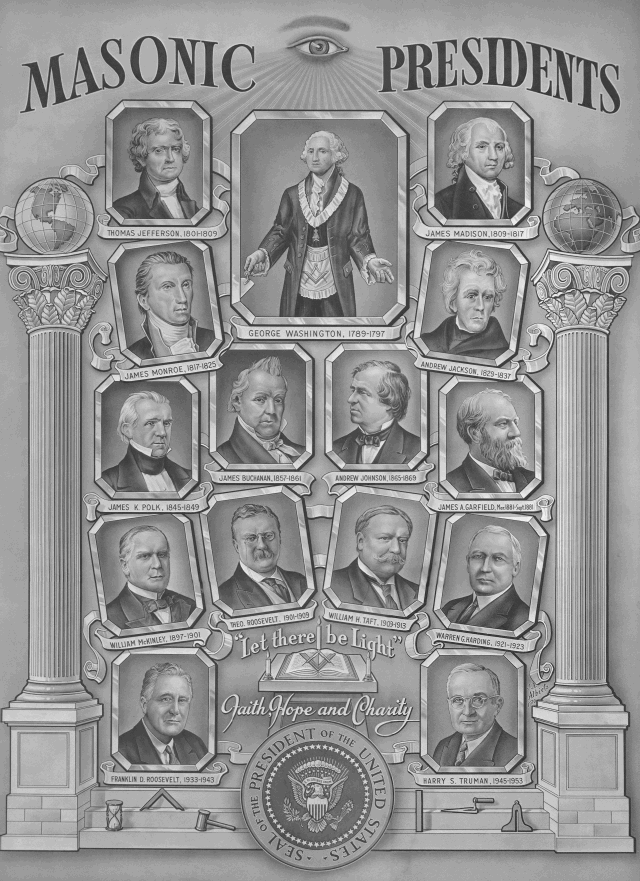
"Proofs" Examined
To "prove" Russell was a Freemason, proponents draw upon the following lines of reasoning:
- He used multiple Masonic Symbols in his publications
- He is buried under a pyramid, which is a Masonic Symbol
- He is buried on or near a Masonic Temple/Center
- He gave a speech in which he mentioned he was a Mason
- Freemasons removed his name from the registry because they are ashamed of him.
Masonic Symbols
Russell used the following symbols in Watchtower publications.
- The Pyramid of Giza
- The Winged Sun Disk
- The Cross and Crown
- The Watch Tower
- Two Pillars
- The All Seeing Eye
- The Pleiades
- YHWH
Whilst these symbols are used by Freemasonry, Russell's usage is not evidence he was a member. These symbols are not exclusive to Freemasonry, and were in common usage amongst a number of nineteenth century Christian groups, such as the Adventist movement from which Russell drew many of his teachings.
For example, the Scriptural relevance of the Great Pyramid was a common topic of Adventists, including Charles Piazzi Smyth, from whom Russell drew inspiration.
Russell adopted the Winged Solar Disk as a symbol of Malachi 4:2.
"And to YOU who are in fear of my name the sun of righteousness will certainly shine forth, with healing in its wings; and YOU will actually go forth and paw the ground like fattened calves." New World Translation, 1984 version
The Cross and Crown is used by various religions, including Catholicism. It is a Christian symbol that implies sacrifice (the Cross) and reward (the Crown).
The use of symbols do not prove that Russell was a Freemason. Watchtower doctrine and symbols were plagiarized by Russell from many sources, including those which are now considered pagan by Watchtower and Jehovah's Witnesses. These symbols were used years and even decades after 1919, the year which Watchtower claims Jesus chose them for being "clean." For more information, see the article Da Vinci Code.
Russell is Buried Beneath a Pyramid
Russell is not buried beneath a pyramid. Russell died on October 31, 1916 and was buried in a regular grave. In 1919, more than 2 years after his death, the Watchtower Society arranged for the erection nearby of a pyramid-shaped monument, out of respect for the prophetic significance Russell placed on the pyramid.
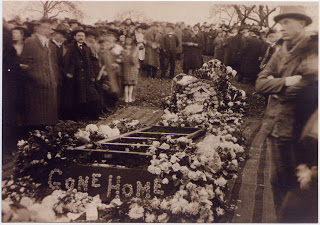
The picture above shows Russell's funeral with a simple headstone and no pyramid. The I.B.S.A. Convention Report for 1919 discusses plans to make the monument. You can see the picture below, which comes from that convention report:
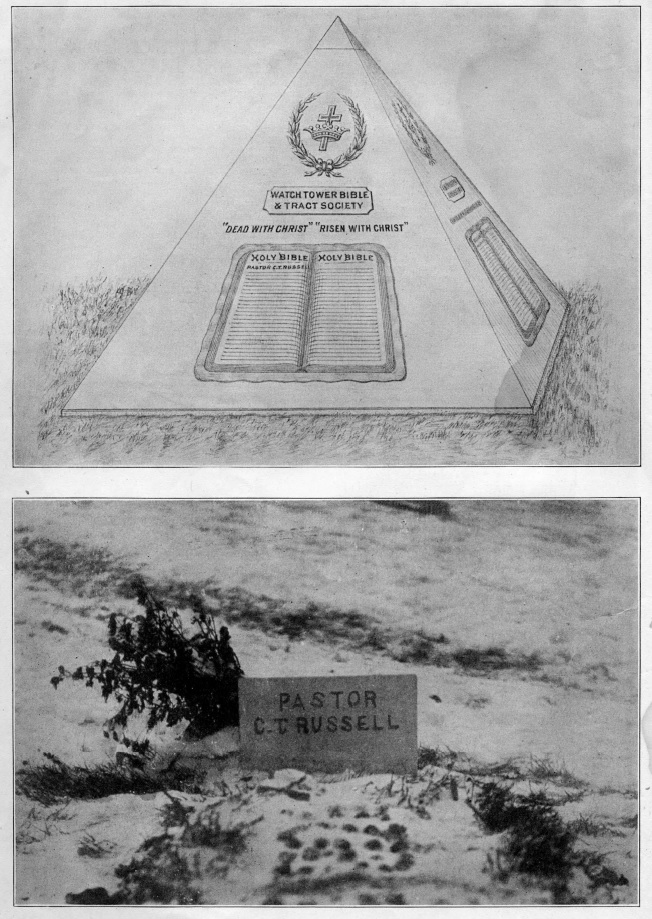
The report says the following about the tomb visit:
"We visited the marble works and there watched the workmen slowly but surely chisel out the monument to be erected as a memorial to the Society.
The Watch Tower Society burial lots in Rosemont United Cemeteries, five miles due north of Pittsburgh City, contain ample grave space for all the members of the Bethel family, and the Pilgrims and their wives-in all more than 275 adult graves. In the exact center of the Bethel lot will be erected diagonally the Pyramid Shape Monument as designed by Brother Bohnet, and accepted by Brother Russell as the most fitting emblem for an enduring monument on the Society's burial space. The size of this structure is nine feet across the base, and its apex stone is exactly seven feet above the ground surface level. It rests upon a concrete foundation five feet deep and heavily reinforced with barbed wire, the work of Brother Bohnet, who would not entrust this important task to anyone else, so we are assured the job was well done. The brother. gave a full description of the securing of the rock material (after fruitless attempts extending over a period of about five years) at the time he piloted the conventionists to the cemetery and urged us to help ourselves to souvenir chips in the shop of the granite worker near by.
These monster blocks of pink (Brother Russell's favorite tint) granite were brought all the way from Granite Mountain Quarries, near Marble Falls City in Texas, upon a special flat car, and are said to be about 95 per cent flint rock.
Each slope of the pyramid will face one of the large lots and on each of these slopes is cut in four-inch embossment a Teacher's Bible, on the pages of which will appear the names of the ones buried there. The burial space for Brother Rutherford was indicated and his name, like that of Brother Russell, will be at the top of opposite Bible pages. A Bible space being set apart for the Pilgrims -all in one lot of forty-eight grave space, so all their names will appear on the same Bible.
Above the Bibles are spaces for inscriptions in full, W. T. B. & T. S., I. B. S. A., "Dead with Christ," "Risen with Christ," etc. And above these the Cross and Crown and Wreath, and the whole capped with the apex stone, highly polished-its shape of course being pyramidal.
Within the structure, incased in a block of granite, will be a sealed metal box in which is a complete set of Karatol Scripture Studies, the Memorial Tower, and one of every tract, photographs of Pastor Russell, a copy of the Society's charter, and many other things to interest the people who at some future date may open the pyramid and find them.
Brother Wm. B. Hurst, of Pittsburgh, who was assistant superintendent of the United Cemeteries under Brother Bohnet's general charge, will have the care of Brother Russel's grave in the pilgrimage absence of Brother Bohnet. It is expected the monument will be in place before the next Decoration Day. Any truth people desiring a chip of the stone may send postage enough to carry a piece about the size of an egg, with enough additional to pay the Society for the trouble of having it wrapped for the mail. Best for class members to order collectively.
A modern picture of Russell's grave shows he is not entombed in the pyramid, but has a regular headstone, containing no Masonic symbols.
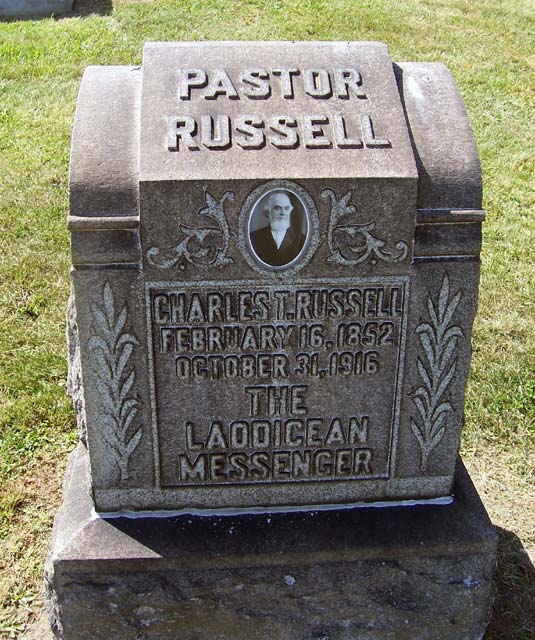
The pyramid monument is located a few meters from the headstone.
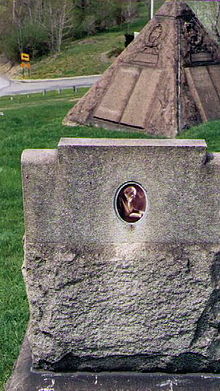
Russell Is Buried in a Masonic Temple
Russell is not buried in a Masonic Temple. There is a Masonic Center near Russell's cemetery, but its proximity had no connection in choosing the plot for Russell, as it was not built until 1996, 80 years after Russell's death. At the time of Russell's burial, the land was owned by the Catholic Church.
The following pictures show the relation of Russell's grave, the Pyramid Monument, and the Greater Pittsburgh Masonic Center, to each other:
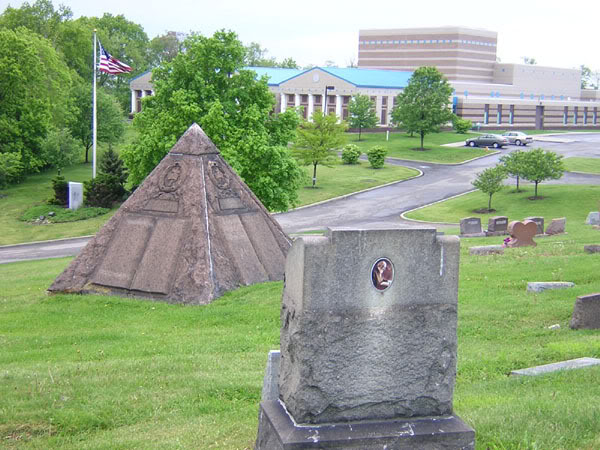
The pictures below, both at ground level and satellite, show that the Masonic Center was not in existence until 1996.
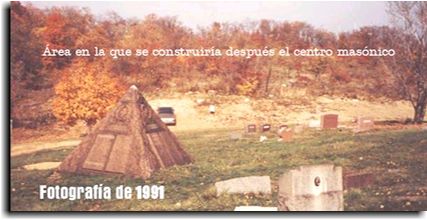
Satellite images comparing the area between 1993 and 2015.
Pre-1996, Pittsburgh Masons met in the Pittsburgh Masonic Temple, located at 4227 Fifth Ave, Pittsburgh, PA 15260, USA. The building was sold in 1993 to the University of Pittsburgh. You can see the newspaper report of the sale here. Also, the Masonic Newspaper The Northern Light, August, 1996, pages 6 to 7, mention the construction of the Greater Pittsburgh Masonic Center. Notice the reasons given for the location were purely financial.
"The final touches are being made to the new Greater Pittsburgh Masonic Center in preparation for a grand opening... The former Masonic Temple, located in the Oakland section of Pittsburgh, was completed in 1915. In recent years, rising costs of operating the building, primarily because of real estate taxes, necessitated the raising of assessments on the bodies meeting in the old building. This, in turn, resulted in bodies finding other meeting locations.
In 1993, the University of Pittsburgh approached the Masonic Temple Trustees, who held title to the property... negotiations culmina[ted] in the purchase of the Temple by the University on Dec. 23, 1993. for a price of $8.6 million. The University agreed to allow the Masons to continue occupancy until December 1995, to afford time for the erection of a new facility. The date was later extended to May, 1996...
Primarily because of tax considerations, the group investigated properties outside the city limits. They found that a 42-acre plot of land was available for purchase from the Catholic Diocese of Pittsburgh. On April 5, 1994, the Board voted to purchase the property, located on Cemetery Lane in Ross Township. Groundbreaking too place on September 21, 1994...
The cornerstone was laid in an impressive ceremony conducted by the Grand Lodge of Pennsylvania on October 9, 1995."
Gave a Speech Where He Said He Was a Freemason
Russell gave speeches in many places. In 1913, in a speaking tour, he gave a speech in a Masonic Temple to an audience that included many Freemasons. It is not necessary for one to be a Mason to either enter into a Masonic Temple or use the facilities for events. For example, I have entered into a Masonic Temple, and seen all of the symbols used. The Greater Pittsburgh Masonic Temple has a part of its website dedicated to having events, such as weddings, in the Center. The speech can be found in its entirety here, starting on page 914.
This speech, when one reads it carefully in its full context, shows that Russell was trying to use what he knew about Freemasonry to make parallels between them and his interpretation of the Bible.
This was not unlike the Apostle Paul, who said in 1 Corinthians 9:19-23:
"For, though I am free from all persons, I have made myself the slave to all, that I may gain the most persons. 20 And so to the Jews I became as a Jew, that I might gain Jews; to those under law I became as under law, though I myself am not under law, that I might gain those under law. 21 To those without law I became as without law, although I am not without law toward God but under law toward Christ, that I might gain those without law. 22 To the weak I became weak, that I might gain the weak. I have become all things to people of all sorts, that I might by all means save some. 23 But I do all things for the sake of the good news, that I may become a sharer of it with [others]."
Russell was trying to "make himself a Mason to win over Masons," but he showed he knew little about Freemasonry.
For example, in this part of the speech, Russell called the Masons a "denomination."
"As Christian people, Bible Students from all denominations, it would seem that we have something in our faith that is in sympathy and harmony with each denomination, the world over. Do our Presbyterian friends speak of the election? We more. Do our Methodist friends have the doctrine of free grace? We more. ... Do our Masonic friends understand something about the Temple, and being Knights Templars, and so on? We more...
Freemasons do not consider themselves to be a denomination or religion. Freemasonry FAQ pages says:
"Freemasonry is not a religion, nor is it a substitute for religion. It requires of its members a belief in God as part of the obligation of every responsible adult, but advocates no sectarian faith or practice. Masonic ceremonies include prayers, both traditional and extempore, to reaffirm each individual's dependence on God and to seek divine guidance. Freemasonry is open to men of any faith, but religion may not be discussed at Masonic meetings." (viewed 26 Apr 2017)
Russell's speech continues:
"I am very glad to have this particular opportunity of saying a word about some of the things in which we agree with our Masonic friends, because we are speaking in a building dedicated to Masonry, and we also are Masons. I am a Free Mason. I am a free and accepted Mason, if I may carry the matter to its full length, because that is what our Masonic brethren like to tell us, that they are free and accepted Masons. That is their style of putting it. Now I am a free and accepted Mason. I trust we all are. But not just after the style of our Masonic brethren. We have no quarrel with them. I am not going to say a word against Free Masons. In fact, some of my very dear friends are Masons, and I can appreciate that there are certain very precious truths that are held in part by our Masonic friends.
I have talked to them at times, and they have said, How do you know about all of these things? We thought nobody knew anything about these things except those who had access to our very highest logic. I said that I had been in conference with the Great Master Workman, the Lord himself, and I have secret information through the Holy Spirit and guidance in respect to what the Bible says, and that contains all the truth, I believe, on every subject. And so if we talk to our Masonic friends about the Temple and its meaning, and about being good Masons, and about the Great Pyramid, which is the very emblem they use, and what the Great Pyramid signifies, our Masonic friends are astonished. One who had been a Mason a long time recently bought a lot of books that had the Great Pyramid discussed, and sent them to I am sure a thousand Masons. He paid for them and sent them out at his own expense. He wanted the Masons to see something about the Great Pyramid. He knew they were greatly interested in that. But we are not going to discuss the Great Pyramid this afternoon. We are going to discuss free and accepted Masonry-- the Bible Masonry, my dear friends."
The vast majority of the sources that claim that Russell was a Freemason only quote the part where he says "I am a Free Mason". But only a few paragraphs later, with some more context, he says that he is not a Mason, and it becomes clear that he was making an analogy.
Those looking to "prove" Russell was a Mason generally neglect to quote the following section:
"Now the question arises, How can we become members of this order? Would you like to become one of these Knights Templar on the heavenly plane. I am not saying anything against the earthly Knights Templar. You can use your own judgment... If you think it is the will of God you should join the Odd Fellows, and don't feel you are Odd Fellow enough in becoming a follower of the Lord, go and join the Odd Fellows. If you feel that you want to become a member of the Free and Accepted Order of Masonry, and do not feel free and Masonic enough as a follower of Christ, God bless you, use your judgment; that is yours to decide, not mine.... Although I have never been a Mason,, I have heard that in Masonry they have something which very closely illustrates all of this... I have often wondered where they found out so many of the secrets of our High and Accepted Order of Masonry.... More than that, our Masonic friends have great trouble in keeping their secrets from leaking out, but God in his great Secret Society has fixed it so that you can tell all you like about it, and the other man cannot understand it unless he has the key.... So, then, I repeat what Jesus said about the terms of membership. I do not know if we are all members of this order or not. You know our order is so secret we cannot know each other always. Is not that wonderful? I find that is so with Masons also. Many Masons shake hands with me and give me what I know is their grip; they don't know me from a Mason. Something I do seems to be the same as Masons do, I don't know what it is; but they often give me all kinds of grips and I give them back, then I tell them I don't know anything about it except just a few grips that have come to me naturally. "
When one reads the entire speech in its context, it is clear that Russell gave no evidence of being a Mason, and rather directly denied being one.
He Was a Mason but They're Ashamed of Him
Freemasonry have or have had members that have done things that disgrace the fraternity. For example, in the Masonic Info website, you can read about many persons who were Masons and committed fraud, were racists, drove under the influence, and many other things. Even though they're not happy this has occurred, they do not deny their involvement as Masons. If Freemasons are honest enough to admit that their membership included criminals, corrupt politicians and cult leaders such as Joseph Smith, there is no reason to hide the involvement of Russell.
Conclusion
The way to confirm a person as a Freemason is to check Lodge Registries. Since Charles Taze Russell can't be found in any Lodge registry, historians agree that he was not a Freemason. Freemasons likewise deny Russell was one. There are many powerful and famous people who were Freemasons, such as Presidents of the United States and religious leaders, of which their membership is no secret.
To believe Russell was a Freemason implies a conspiracy to hide his involvement that is both pointless and devoid of any evidence. Russell was neither a Mason, pagan or Satanist, but simply a religious leader stealing ideas from those around him to found his own religion.
This does not mean the Watchtower religion that Russell founded is harmless. Jehovah's Witnesses most certainly follow to a high control group / cult and there are numerous important reasons why it is harmful to be a Jehovah's Witness. But no, Charles Taze Russell was not a Freemason.
Written April 2017.
![]() Paul Grundy 2005 - 2025
Paul Grundy 2005 - 2025
